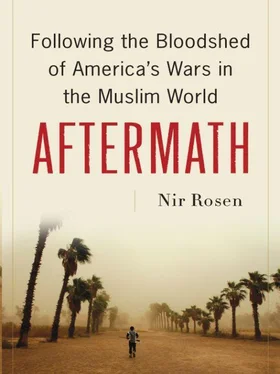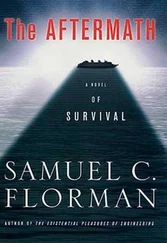Across Baghdad, I met other Awakening leaders who were experiencing the same frustrations that Ibrahim had. In Adhamiya I met Abu Omar, or Khalil Ibrahim, one of the Awakening leaders in the area. It was the birthday of the Prophet Muhammad, the first time I had ever seen a festive mood and celebration in a Sunni part of the country, yet Abu Omar was not in a festive mood himself. I found him chatting with American soldiers across the street from the mosque. When he finished with them, he took me to sit with him on plastic chairs in the square by the mosque. Abu Omar had dark red skin, a bulbous nose, small eyes, and a large belly. As we sat and drank tea, small boys ran around us. One of them, whose father was a slain Awakening fighter, played with a plastic pistol, shooting at us. The main square was adorned with pictures of slain Awakening fighters, including two of Abu Omar’s sons. I worried about suicide bombers, since several of Adhamiya’s Awakening leaders had been killed by them. And it was a Yemeni suicide bomber who killed one of Abu Omar’s sons.
Adhamiya was the last Sunni enclave in eastern Baghdad. “If the Awakening wasn’t here, then in twenty years the Iraqi army and U.S. Army wouldn’t be able to come in,” Abu Omar said proudly, bragging that “this was the third-hottest area in Iraq.” He was also proud that Saddam had made his last appearance in his neighborhood. Abu Omar fought the Americans on that day as well. “There were eleven Syrians [foreign fighters], God have mercy on them,” he said. “They were martyred here.” I asked him how he could collaborate with his former enemies. “The Americans are leaving, but the Iranians are staying,” he told me.
In November 2007 Abu Omar joined the Awakening in his area with thirteen other family members. “Two previous groups tried but failed,” he said. “They sat and would watch the killers.” Most of the killers were from outside Adhamiya, he said. Abu Omar had been a noncommissioned officer in Iraqi army intelligence, with nineteen years of service. He claimed that after the war he was jobless and sold gasoline on the black market. “We saw the killing and kidnapping,” he said, and wanted to put an end to it. The Americans approached them through the Sunni endowment. After an initial confrontation with Al Qaeda, Abu Omar and his men seized the Abu Hanifa Mosque. A comrade called Abu Muthana got on the mosque’s loudspeakers and issued a statement to the people of Adhamiya, announcing the establishment of their Awakening group and their aim to rid the area of Al Qaeda. (Abu Muthana had since been arrested by the Iraqi authorities.) After Abu Muthana’s statement, Al Qaeda men in nearby buildings opened fire on them, and one of Abu Omar’s men was killed. Abu Omar says his men captured many Al Qaeda members and handed them over to the Americans.
Sheikh Ahmad al-Taha, the son-in-law of Ahmad Abdel Ghafur al-Samarai and the deputy of Harith al-Dhari from the Association of Muslim Scholars, was now the imam of the Abu Hanifa Mosque. “All bad things come from this mosque,” he said, pointing to it. Al Qaeda used to keep prisoners inside it, he said, and one day five IEDs were placed next to the mosque on the street. He did not believe they could have been placed without the cognizance of people in the mosque. The mosque graveyard was an IED factory, he claimed, and his men had found RPGs and explosives in the mosque.
At first Abu Omar’s men clashed with the Iraqi army, and he once waged a three-hour gun battle with them. “We don’t accept the Iraqi police here,” he told me. “They can only come with the army. We don’t like them—they’re all militias.” He too was apprehensive about an American withdrawal, telling me that the civil war would resume. A friend of his called Abu Karar, who was a member of Iraqi intelligence, had joined us at the table. “I disagree with you, Abu Omar,” he said. “Nothing would happen if the Americans left.” I asked Abu Omar why he did not unite with other Awakening leaders to form a stronger front. “We tried in 2008,” he told me. “Awakening leaders couldn’t join together because they couldn’t agree among themselves.”
This failure to unite would become painfully obvious on March 28, 2009, when clashes erupted in Baghdad’s Fadhil district after the Iraqi army arrested Adil al-Mashhadani, the head of the local Awakening group. Mashhadani’s men staged a two-day uprising, and the U.S. Army ended up rescuing its Iraqi counterparts. The clashes provoked speculation that the surge in American troops, to which the dominant narrative attributed the drop in violence, was unraveling or that the civil war might restart. I had been hearing about Mashhadani from Shiites since 2007. Supporters of Muqtada al-Sadr, in particular, were upset that someone like Mashhadani—who, they believed, used to slaughter Shiite civilians—had been empowered by the Americans. One U.S. national security official told me that the Americans had held information on Mashhadani for years but considered him one of the first insurgents to see which way the wind was blowing. They had wanted him arrested at one point, but the Iraqi army was not ready yet. The official had been concerned that other Awakening groups would rise up; he was relieved to see that none did.
In fact, the ill-fated uprising in Fadhil was best seen as confirmation that the civil war between Sunnis and Shiites was over and could not begin again—not because of any reconciliation process or political settlement, neither of which had happened, but because the Shiite victory was definitive and the Sunni militias were crushed. The cleansing of Sunnis from much of Baghdad left Sunni insurgents with no sea of people to swim among. Shiites had numerical superiority and the growing strength of the state and its security forces, which they dominated, along with the support of the world’s only superpower.
Following the clashes between the Supreme Council and the Mahdi Army, and then Prime Minister Maliki’s assault on Shiite militias, there was no longer a unified Shiite bloc but instead a central government confident in its victory and eager to assert its full authority. One Iraq expert from the U.S. Army who worked closely with Gen. David Petraeus told me in 2008 that the civil war would end when Shiites realized they had won and Sunnis realized they had lost. Both sides had now come to those realizations. Advocates of the surge hoped that following the drop in violence a political settlement could be reached between Iraq’s warring factions. But this wouldn’t happen, and it wasn’t necessary. The burgeoning Iraqi state, embodied by Maliki, could simply continue to expand its power. The more Maliki became a new Saddam, the more popular he became among Iraqis. But he actually had to earn support and provide services, because he answered to the Shiite majority. And his power was checked by other factions and by an energetic Parliament that controlled the purse strings.
In November 2008 the Americans handed authority over nearly one hundred thousand Awakening group fighters to the Iraqi government. But few were hired. Although in 2008 the Iraqi government agreed to integrate these men into the security forces or government ministries by the end of 2009, it had to push that back until mid-2010. But in April 2010 the U.S. special inspector general for Iraq reconstruction reported that only 37,041 had been integrated, even though the Iraqi government claimed the number was fifty thousand. But the Iraqi government declares an Awakening man integrated once he has been offered a job, regardless of whether he accepts it.
Senior Awakening leaders and many of their men were systematically arrested. Others were simply removed from their posts and told to go home. It was a quiet and slow process, but one that continued to emasculate the last groups that could compete with the state for authority. There was nothing the Awakening groups could do. As guerrillas and insurgents, they had been effective only when they operated covertly, underground, blending in with a Sunni population that was crushed in a brutal Shiite-led counterinsurgency campaign, which depopulated Sunni areas. Now the former resistance fighters were publicly known paid guards—their names, addresses, and biometric data possessed by the Americans and Iraqis. They could not return to an underground that had been cleared, so they were cornered. They had failed to unite, and many were on the run. Some had left the country, and others were being tried in court for killing the very Al Qaeda men the Americans had originally wanted them to kill.
Читать дальше











